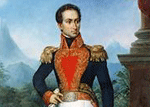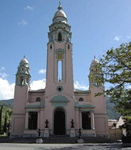Simón
Bolívar
(1783-1830)
Venezuelan
Liberator of
 |
|---|
FIRST
PHASE OF BOLÍVAR'S LIFE
1783 Simón Bolívar was born in
He
came from a rich and influential family of criollos whose first members
arrived in
His
teachers (tutors) were Andrés Bello, the most prominent humanist and grammarian
of Bolívar's lifetime, and Simón Rodríguez,
who was an outspoken iconoclast and rationalist.
Due
to their French-influenced teaching, Bolívar can be considered a disciple of
the social and political doctrines of Jean-Jacques Rousseau.
His
parents died when he was very young, and he was raised by an uncle who paid
little attention to him.
1799 He
went to
1802 Bolívar
married María Teresa Rodríguez
del Toro y Alaysa, the niece of the Marqués de Toro
(a prominent city in
1804 He
traveled to
1806 He
traveled to the
"It
is amazing that this model in North America should subsist so prosperously and
should not become entangled at the appearance of the first obstacle or
danger—although that nation is a rare model in political virtues and in
moral examples—and granting the fact that liberty was its cradle, and
that it was reared and nourished on freedom—I will say it all, although
this nation is unique in the history of mankind, it is prodigious, I repeat,
that a system so weak and complicated could have governed it through
circumstances so difficult and delicate as the past one."
Bolívar
was, generally speaking, a utopian who hoped to create one American nation, but
he realized that his was not possible.
1810 He
traveled to
SECOND PHASE OF BOLÍVAR'S
LIFE
1811 The
criollos in
Bolívar
and Miranda then returned to
Miranda
is named commander of the rebel army.
1812 (July
12) Bolívar wrote to Miranda promising to give his commander an account of Bolívar's
defeat at
Miranda
surrenders to the Spanish colonial army when Bolívar handed him over to the
Spanish. Bolívar thought Miranda was a traitor, but Bolívar never justified his
action.
Bolívar
flees to
He
wrote his Manifiesto de Cartagena, in which he
analyzes the political, social, and
economic causes—including an earthquake in
1813 Bolívar
named commander of an army in
1814 While
the rebellion is going on in South America, king
Fernando VII returns to the throne of
As
a result of Fernando VII's actions, the prosperous criollos in Nueva Granada (Gran
Bolívar led an army into
1815-1816 Bolívar then fled to first to Curaçao, then to
Then
he went to
During
this time, he wrote a diary about
Ø
Ø Latin America has a heritage of neglect
and ill treatment from
Ø Latin Americans are "passive";
Ø
Ø Democracy and republics are not
appropriate for
Ø
Ø Many small republics would suit Latin
America better than the idea of manifest destiny, which was guiding the
Ø
1816 With the help of Haitian soldiers and
money, which he got from Pétion in exchange for
freeing the black slaves in
Bolívar
then returns to
1817 The
llaneros (men from the plains of central and south
1819 Volunteers
arrive from
Bolívar's battered army
marches to
Bolívar
goes to
1820-1823 Meanwhile,
in
1821 Gran Colombia is declared a reality with
Bolívar as president and Francisco de Paula
Bolívar
marches to
1822 Bolívar
meets with the Argentinian liberator, José de San Martín, in
1823 The
last Spanish forces are defeated in
1824 Bolívar
commands the rebel forces in the great battle of Junín (August 6th)
while Antonio José de Sucre defeats the last Spanish army at
Bolívar
marches to
1825 Bolívar
liberates Alta Peru, and it is named for him:
Bolívar
returns to
THIRD PHASE OF BOLÍVAR'S
LIFE
1825-1830 There
is violent and bitter factionalism through all of northern
1827 Bolívar
leaves
1828 To
solve the political impasse Bolívar
proclaims himself dictator on August 27th.
Bolívar's
lover, Manuela Sáenz, helps save him from an
assassination attempt.
1828-1830 Uprisings
break out all over Gran
1830 Simón Bolívar resigns his presidency (dictatorship).
He
dies of tuberculosis on December 17th at La Quinta de San
Pedro Alejandrino in
1842 Bolívar's
remains were moved to a Panteón Nacional
(National Pantheon) in
For
a website dedicated to the monument where Simón
Bolívar is buried, click on the following image:




